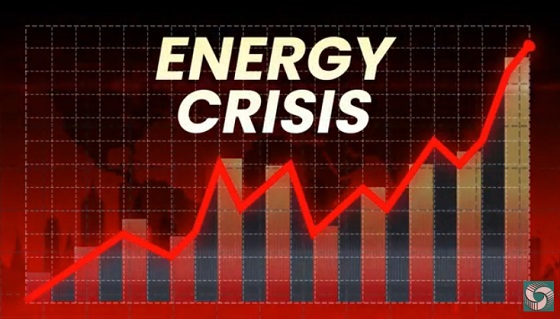Energy
LATE TO THE PARTY: Liberal Resource Minister Minister Suddenly Discovers Canada Needs East-West Pipeline

From Energy Now
By Jim Warren
On Thursday, February 6 federal energy and natural resources Minister Jonathan Wilkinson told reporters about a brilliant idea he’d come up with. He said Canada should think about building an east-west oil pipeline. He claimed doing so could provide Ontario, Quebec and parts further east greater security of supply.
Furthermore, such a pipeline would eliminate the need to buy tanker loads of oil from places like Saudi Arabia and Nigeria. And what’s more it could provide us with the opportunity to export Canadian oil to countries other than the US.
Talk about being late to the party. It’s as though the Energy East project never made it onto the national agenda.
Wilkinson told reporters how a pipeline like Enbridge’s Line 5 is vulnerable to shut down by US authorities. Line 5 carries oil from the prairies through the northern US Midwest before delivering it to the refinery and petrochemicals facilities at Sarnia, Ontario.
This is not breaking news. The Liberals have been well aware of the threat for years. Michigan governor, Gretchen Whitmer waged a well-publicized multi-year campaign to have Line 5 shut down.
According to a CBC report, Wilkinson said, “successive Canadian governments never really gave it much thought that a lot of the energy the country needs to power its economy flows through the U.S.”
That’s a stretch. He apparently doesn’t consider the governments of Alberta and Saskatchewan to be Canadian governments. The real problem is Ottawa wasn’t listening when premiers Notley, Kenney, Smith, Wall and Moe explained the value of an all-Canadian Energy East pipeline. They also had plenty to say about the cancellation of Energy East in 2017 and the role Ottawa played by creating the regulatory approval quagmire that helped kill it.
No less puzzling is that Wilkinson imagines such a pipeline could ever be built under the BANANAs (build absolutely nothing, anywhere, near anything) regulatory barriers implemented by the Liberals which make it next to impossible for anyone to build a new pipeline. When Jason Kenney referred to Bill C-69 as The No More Pipelines Bill he wasn’t just whistling Dixie.
The only major export pipeline to be built in the wake of C-69, was the Trans Mountain expansion (TMX). And it was only completed because the owner, the Government of Canada, was prepared to incur the staggering costs of navigating its own pipeline approval regulations. A pipeline originally budgeted to cost $6.8 billion wound up costing an additional $54 billion. Sane investors simply aren’t prepared to accept that level of unreasonable cost and uncertainty.
A first step in getting new pipelines built would be eliminating Bill C-69 along with Bill C-48, the West coast tanker ban. Wilkinson didn’t touch on those points when telling reporters about his bold new idea.
One has to wonder, after11 years of anti-oil and anti-pipeline policy making, if Wilkinson really means what he’s saying. Has he truly experienced a road to Damascus level conversion due to the threat of US tariffs?
Another plausible explanation for Wilkinson’s call for the resurrection of Energy East is that he’s seen the polling numbers. An Angus Reid poll conducted earlier this month shows 79% of Canadians from across the country support new oil and gas pipelines to tidewater on the east and west coasts. The poll also shows 74% of Quebec respondents now support the idea of building new pipelines to tidewater.

If those numbers hold, Canada’s next government could possibly revisit Energy East. If they succeeded in getting the line built it would represent the most visionary nation building project since the building of the trans-continental railway.
No less surprising is, despite the rise in public support for pipelines, Quebec Premier Francois Legault says he won’t accept a new oil pipeline in his province. Legault is out of step with Quebec opinion on more issues than pipelines. The separatist Parti Quebecois is currently leading Legault’s Coalition Avenir Quebec by 10 points in party preference polls. This is not to say the PQ is any more pipeline friendly.
After11 years of Liberal anti-oil and anti-pipeline policy making, Wilkinson is finally on the right side of the Energy East idea. Some might say better late than never—better to change one’s mind than to continue being wrong. Others will say it is a flip flop of epic proportions and questionable sincerity. Skeptical pundits will question whether Wilkinson’s new found fondness for pipelines is any more credible than Mark Carney’s pledge to get rid of the carbon tax.
Wilkinson is a bright man, so it is possible he has believed Energy East was a good idea for some time. Too bad he didn’t tell us sooner. He waited too long to come clean to expect electoral redemption.
Energy
Federal Clean Power Plan Risks Blackouts And Higher Bills

From the Frontier Centre for Public Policy
Ottawa’s Clean Electricity Regulations could derail Canada’s energy future. Here’s what we need to do
The federal government’s push to make Canada’s electricity system net-zero is running straight into reality—and it’s not pretty.
Through the Clean Electricity Regulations (CER), the government wants all provinces to eliminate greenhouse gas emissions from electricity generation by 2035. It is an ambitious goal, but one that ignores a basic fact: demand for electricity is exploding, and provinces are struggling to keep up.
New technologies like artificial intelligence are supercharging this demand. AI systems, including tools such as ChatGPT, rely on massive data centres—huge warehouses of computer servers that need constant cooling and enormous amounts of electricity to function. According to a recent Royal Bank of Canada report, if all proposed data centre projects in Canada move ahead, they would consume 14 per cent of the country’s entire electricity supply by 2030. That is roughly the same as projections in the United States, where data centres are expected to use up to 15 per cent of the national total.
This is a serious problem. Provinces such as Alberta and Saskatchewan have already raised the alarm, arguing that the federal regulations overstep Ottawa’s constitutional authority. Energy supply, like natural resources, has traditionally been under provincial control. Alberta and Ontario operate their own electricity markets to attract investment and ensure reliability. Federal regulations threaten to undermine these efforts, adding risk and driving up costs.
The situation is already tense. Alberta, for example, issued multiple grid alerts in 2024 due to shortages and market disruptions. The province is now looking at “behind-the-fence” power solutions, encouraging data centres to generate their own electricity to guarantee stability.
Canada was not always in this bind. For decades, we enjoyed an abundance of clean, affordable hydroelectric power. Provinces like Quebec, British Columbia, Manitoba and Newfoundland and Labrador built massive hydro projects starting in the 1960s, creating cheap power and even surpluses to export to U.S. markets. In 2022, for example, B.C. sent 74 per cent of its exported power to the U.S., while Quebec sent 63 per cent and Ontario an impressive 81 per cent, generating billions in revenue.
But that era is coming to an end. Most of the best sites for hydro dams have already been developed. New projects would require expensive, long-distance transmission lines to bring power from remote areas to the cities that need it. On top of that, growing environmental concerns make new dam construction an uphill battle.
The truth is, there is no quick fix. A 2025 study by the Fraser Institute paints a grim picture: to meet future electricity demand solely with solar power would require 1,680 years of construction. Wind power? About 1,150 years. Even hydro would take close to a millennium. Even if we combined these sources, we are still looking at more than 1,000 years to build enough capacity.
Meanwhile, federal projections estimate that Canada’s electricity demand will double by 2050.
Without significant policy changes, Canadians could soon face the worst of both worlds: soaring electricity bills and the threat of power shortages. Our economy could also suffer as companies and data centres look to other jurisdictions with more reliable power supplies.
So what should Canada do? Here are three practical steps:
- Scrap the Clean Electricity Regulations. Provinces like Alberta and Saskatchewan are already committed to reaching net-zero by 2050. Federal interference only creates unnecessary political battles and delays investments.
- Fast-track approvals for new interprovincial transmission lines. Today, building a new transmission line can take more than a decade. Speeding up this process would help provinces share power and avoid costly overbuilding of generation capacity.
- Launch a major low-interest loan program to build new power infrastructure. We need to dramatically expand our generation and transmission systems, including natural gas-fired plants, to meet future demand.
Canadians deserve a reliable, affordable and clean energy future. But we will not get there by ignoring the realities of rising demand and provincial responsibilities. It is time for the federal government to listen to the provinces, embrace practical solutions and avoid an avoidable crisis.
Otherwise, we are on track for blackouts, higher bills and missed economic opportunities.
Maureen McCall is an energy business analyst and Fellow at the Frontier Center for Public Policy. She writes on energy issues for EnergyNow and the BOE Report. She has 20 years of experience as a business analyst for national and international energy companies in Canada.
Economy
The Net-Zero Dream Is Unravelling And The Consequences Are Global

From the Frontier Centre for Public Policy
The grand net-zero vision is fading as financial giants withdraw from global climate alliances
In recent years, governments and Financial institutions worldwide have committed to the goal of “net zero”—cutting greenhouse gas emissions to as close to zero as possible by 2050. One of the most prominent initiatives, the Glasgow Financial Alliance for Net Zero (GFANZ), sought to mobilize trillions of dollars by shifting investment away from fossil fuels and toward green energy projects.
The idea was simple in principle: make climate action a core part of financial decision-making worldwide.
The vision of a net-zero future, once championed as an inevitable path to global prosperity and environmental sustainability, is faltering. What began as an ambitious effort to embed climate goals into the flow of international capital is now encountering hard economic and political realities.
By redefining financial risk to include climate considerations, GFANZ aimed to steer financial institutions toward supporting a large-scale energy transition.
Banks and investors were encouraged to treat climate-related risks—such as the future decline of fossil fuels—as central to their financial strategies.
But the practical challenges of this approach have become increasingly clear.
Many of the green energy projects promoted under the net-zero banner have proven financially precarious without substantial government subsidies. Wind and solar technologies often rely on public funding and incentives to stay competitive. Energy storage and infrastructure upgrades, critical to supporting renewable energy, have also required massive financial support from taxpayers.
At the same time, institutions that initially embraced net-zero commitments are now facing soaring compliance costs, legal uncertainties and growing political resistance, particularly in major economies.
Major banks such as JPMorgan Chase, Citigroup and Goldman Sachs have withdrawn from GFANZ, citing concerns over operational risks and conflicting fuduciary duties. Their departure marks a signifcant blow to the alliance and signals a broader reassessment of climate finance strategies.
For many institutions, the initial hope that governments and markets would align smoothly around net-zero targets has given way to concerns over financial instability and competitive disadvantage. But that optimism has faded.
What once appeared to be a globally co-ordinated movement is fracturing. The early momentum behind net-zero policies was fuelled by optimism that government incentives and public support would ease the transition. But as energy prices climb and affordability concerns grow, public opinion has become noticeably more cautious.
Consumers facing higher heating bills and fuel costs are beginning to question the personal price of aggressive climate action.
Voters are increasingly asking whether these policies are delivering tangible benefits to their daily lives. They see rising costs in transportation, food production and home energy use and are wondering whether the promised green transition is worth the economic strain.
This moment of reckoning offers a crucial lesson: while environmental goals remain important, they must be pursued in balance with economic realities and the need for reliable energy supplies. A durable transition requires market-based solutions, technological innovation and policies that respect the complex needs of modern economies.
Climate progress will not succeed if it comes at the expense of basic affordability and economic stability.
Rather than abandoning climate objectives altogether, many countries and industries are recalibrating, moving away from rigid frameworks in favour of more pragmatic, adaptable strategies. Flexibility is becoming essential as governments seek to maintain public support while still advancing long term environmental goals.
The unwinding of GFANZ underscores the risks of over-centralized approaches to climate policy. Ambitious global visions must be grounded in reality, or they risk becoming liabilities rather than solutions. Co-ordinated international action remains important, but it must leave room for local realities and diverse economic circumstances.
As the world adjusts course, Canada and other energy-producing nations face a clear choice: continue down an economically restrictive path or embrace a balanced strategy that safeguards both prosperity and environmental stewardship. For countries like Canada, where natural resources remain a cornerstone of the economy, the stakes could not be higher.
The collapse of the net-zero consensus is not an end to climate action, but it is a wake-up call. The future will belong to those who learn from this moment and pursue practical, sustainable paths forward. A balanced approach that integrates environmental responsibility with economic pragmatism offers the best hope for lasting progress.
Marco Navarro-Genie is the vice president of research at the Frontier Centre for Public Policy. With Barry Cooper, he is coauthor of Canada’s COVID: The Story of a Pandemic Moral Panic (2023).
-

 Energy2 days ago
Energy2 days ago‘War On Coal Is Finally Over’: Energy Experts Say Trump Admin’s Deregulation Agenda Could Fuel Coal’s ‘Revival’
-

 COVID-192 days ago
COVID-192 days agoThe Pandemic Justice Phase Begins as Criminal Investigations Commence
-

 Economy1 day ago
Economy1 day agoThe Net-Zero Dream Is Unravelling And The Consequences Are Global
-

 2025 Federal Election2 days ago
2025 Federal Election2 days agoBefore the Vote: Ask Who’s Defending Our Health
-

 2025 Federal Election1 day ago
2025 Federal Election1 day agoHomebuilding in Canada stalls despite population explosion
-

 2025 Federal Election2 days ago
2025 Federal Election2 days agoThe “Hardhat Vote” Has Embraced Pierre Poilievre
-

 2025 Federal Election18 hours ago
2025 Federal Election18 hours agoCarney’s Fiscal Fantasy: When the Economist Becomes More Dangerous Than the Drama Teacher
-

 Addictions1 day ago
Addictions1 day agoAddiction experts demand witnessed dosing guidelines after pharmacy scam exposed





